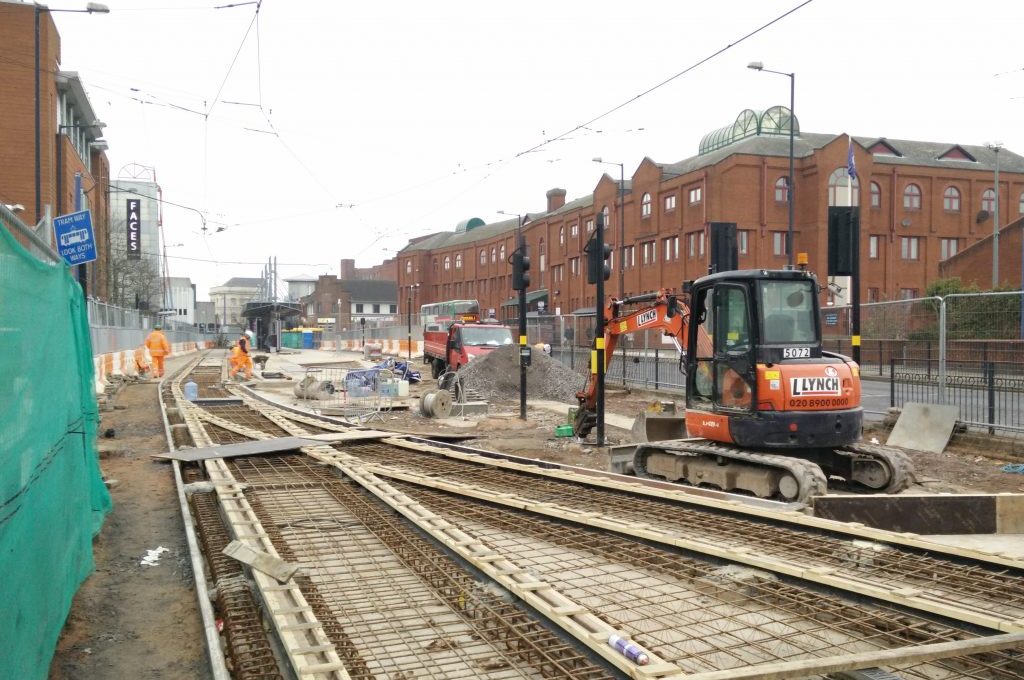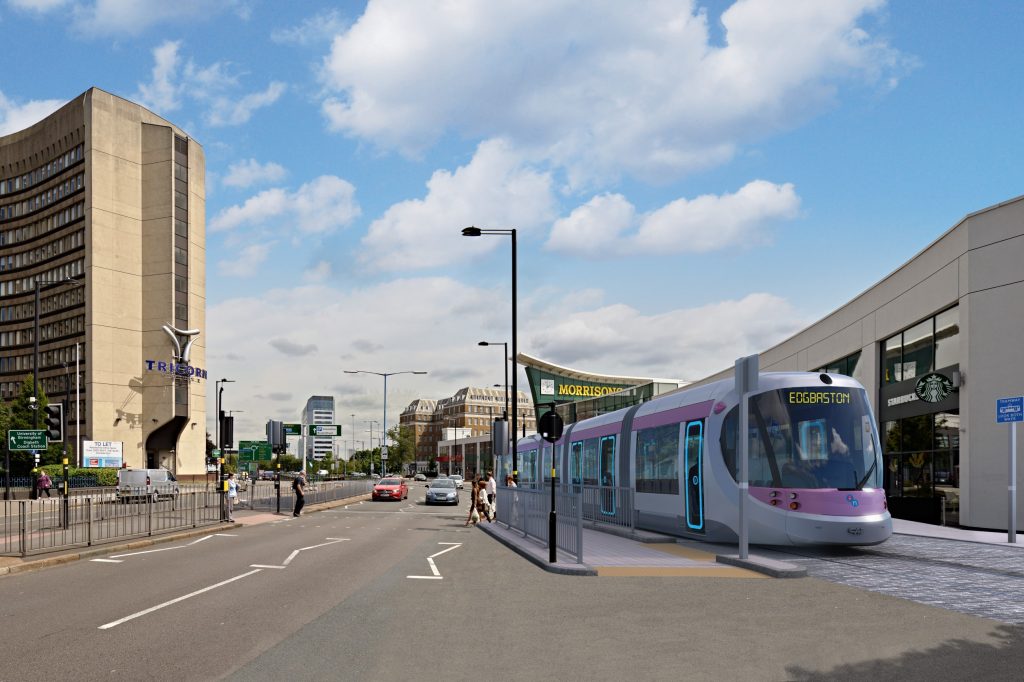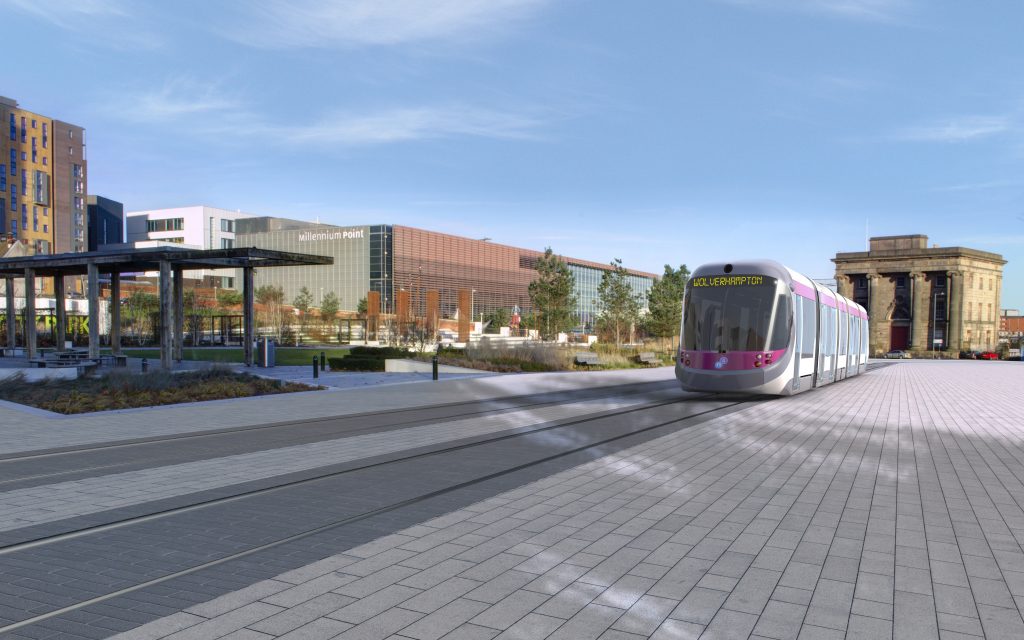The Midland Metro Alliance came into effect on 4 July this year with the ambitious remit to expand the Midland Metro network still further. It is a partnership of nine organisations that aims to “transform the West Midlands by delivering the best integrated transport system for the future” and to contribute to both the social and economic regeneration across the region, delivering local jobs, upskilling and training.
The employees of all nine companies work together as one team. Even their business cards hint at this arrangement. Brightly coloured in magenta, with the logo and values clearly on the back, the front of the card has a cartoon showing three people looking at a drawing of the tram route. They work for different companies, but none of the company logos are visible.
They all work for the alliance, which is basically an agreement between three parties – the client (the West Midlands Combined Authority), the construction contractor (Colas Rail supported by partners Colas Ltd, Barhale, Thomas Vale and Auctus Management Group) and the designer (a consortium of Egis, Tony Gee and Pell Frischmann).
Why an alliance?
Phil Hewitt, Midland Metro programme director at Transport for West Midlands (TfWM), explained why the alliance concept was chosen: “The development of tram systems can be considered as high risk because, not only do they tend to have a very high public profile, there are also lots of unknowns when working on urban streets. For smaller schemes, the profitability can be relatively low and thus commercially unattractive under normal contractual arrangements.
“In addition, there is a danger of losing expertise on completion of smaller schemes, and therefore we felt that a move towards an approach that allows for a more strategic and continuous development of both skills and resources would be beneficial. This way, each scheme can build on the experience of the last so that there is always continuous improvement in techniques and performance.”
Building on lessons from past projects, the concept of the alliance is to ensure that all parties are incentivised to work together with the gains and losses shared between them.
Neil Farmer, executive director of alliance member Tony Gee and Partners, developed that theme: “With all these schemes either reaching delivery or in the planning stage, the original system is due to triple in size by 2026. Therefore, the decision was taken not to design the schemes as individual projects, but rather to take an holistic approach to system-wide design.”
Another unique feature of the alliance is the commitment to innovation. Raising cash for research and development (R&D) is notoriously difficult – particularly in the public sector, but in the alliance, savings made will be ring-fenced to be used for this. By ring fencing some of the savings made by the teams it will be possible to develop better ways of delivering a world-class metro system.
While the office is staffed by individuals from the various partner companies, this is not immediately obvious. Staff are all encouraged and trained to see themselves as, first and foremost, working for the alliance rather than their own parent company.
Collaborative working is central, as is the development of a ‘no blame’ culture, but one where individuals are empowered to challenge the ways of working in order to find the ‘best for the alliance’ solution.
Planning for the future
Looking around Birmingham, it is clear that the Midland Metro is not the only show in town. The cranes are back and construction is booming. This is both a blessing and a challenge for the development of the Midland Metro.
A blessing, because it means that there really will be a need for an efficient transport system once the building works are complete, and a challenge since land will be at a premium, as will the availability of skilled staff. But if the alliance can plan strategically and train people to work on its system then, to some extent, it will have a more secure labour resource for the longer term.
And the alliance really is focusing on the longer term with a 2030 study. Midland Metro Alliance director Alejandro Moreno is keen to emphasize its value. He said: “It looks strategically at how the network will be operating in 2030 and beyond, as well as how it needs to be designed, looking especially at asset management and whole life cycle costs. The study doesn’t look at the details, but examines what needs to be done to ensure that the system will perform at its best for the city and across the West Midlands.”
Phil Hewitt agreed. “This will let us optimise the delivery strategy so that we can challenge those historic assumptions about how we do things and how long they should take. It is very exciting to have the opportunity to take this sort of long-term view – it’s a really exciting time to be here.”
So, over the next ten years, and maybe a little longer, there will be a marked transformation of the transport network in Birmingham.
Birmingham routes
At this point it is perhaps worth recapping on what has happened with the Midland Metro. The original system began operation in 1999. The 20.4km track, serving locations such as the Jewellery Quarter, West Bromwich, Wednesbury and Bilston, ran mainly along the former railway line between Birmingham Snow Hill and Wolverhampton, with a short section of on-street running along Bilston Road to the terminus at St. Georges in Wolverhampton.
Birmingham’s Midland Metro city centre extension was opened in May this year by Her Majesty the Queen, extending the tram service from Birmingham’s Snow Hill station to New Street station, bringing the tram right into the centre of the city along busy retail and commercial streets. This extension was part of a £128 million project that saw the purchase of a new 21-strong fleet of Urbos 3 trams, a refurbished depot at Wednesbury and new stops at Snow Hill, Bull St, Corporation St and Grand Central.
From the current terminus at Stevenson Street, right outside the entrance to Birmingham New Street station, there is a logical route along Pinfold Street, past the imposing Town Hall, to Centenary Square. That’s where some of Birmingham’s key attractions are located – the International Convention Centre, Symphony Hall and the Library of Birmingham with its walls made of hoops.
The extension to Centenary Square will provide 840 metres of twin track with trams designed to run on battery power, so avoiding the need for intrusive overhead line equipment in an area of architectural significance. The Urbos 3 trams were purchased originally with the option for battery traction so will be retro-fitted with the equipment ready for the new service which is due to start in 2019.
Funding has been earmarked to extend the route further along Broad Street, past Five Ways and on to Edgbaston by 2021.
To the east, there has been an application for a Transport and Works Act Order to build and operate the Birmingham Eastside extension from Bull Street to Digbeth, near to Birmingham Coach Station. Once granted, the order would allow work to start on the 1.7km extension which will serve the proposed HS2 station at Curzon Street, offering connections to New Street, Moor Street and Snow Hill train stations, as well as the bus services including the planned high speed Sprint service.
The route will fork at the junction of Bull Street and Corporation Street and run along Lower Bull Street past the southern edge of the proposed Martineau Galleries re-development to Albert Street.
It will then cross Moor Street Queensway towards Curzon Street and continue along New Canal Street before running into Meriden Street and turning left onto Digbeth High Street with a terminus between Digbeth Coach station and the Custard Factory – Birmingham’s ‘revolutionary entertainment, creative, digital and media quarter with office space, event venues, independent shopping and industrial space’.
Subject to any local public inquiry, work is scheduled to begin in 2019 and the line planned to open to the public in 2023. A number of new trams will come into use at the time that this extension is open to the public, to bolster the current fleet of 21 and provide a service running every six minutes.
The alliance is also working on the early phase of development of a scheme for the system to be extended past High Street, Deritend, via Birmingham City Football Club, Heartlands Hospital and Chelmsley Wood to Birmingham Airport/NEC/Birmingham International Station, with a new terminus at the HS2 Interchange Station in north Solihull. This will provide a key point of interchange for HS2 as well as massively improving accessibility to job opportunities for those living in this area.
Outside Birmingham
In Wolverhampton, permission has just been granted by the Government to begin work on the £18 million city centre extension to both the train and bus stations, with completion scheduled for 2019.
Ensuring the benefits of Metro are shared across the West Midlands, a business case is being prepared to extend the Metro from Wednesbury to Brierley Hill which is an 11.5km route that runs largely along a disused rail corridor, deviating onto the highway to access Dudley town centre and Merry Hill with the terminus at Brierley Hill.
The increased capacity of the expanded network will require a new fleet of trams and a new depot to ensure that the infrastructure can operate efficiently. The control room will also require upgrade to enable it to be sufficient to manage multiple routes.
The capacity, resilience and reliability of power, systems and sub-systems will be reviewed to ensure that, when systems need to be renewed or upgraded due to being life expired or due to the requirements of an individual project, the longer term plans are taken into account. This will significantly improve the reliability of the network, and help the system to deliver one of the frequently stated priorities from customers.





